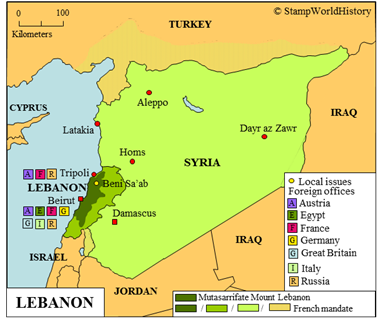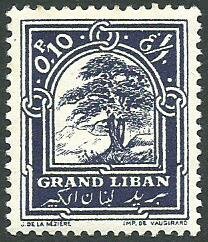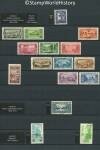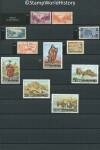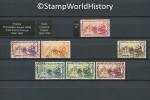لبنان
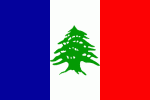
Lebanon
Mandated territory
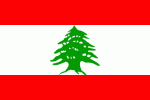
Lebanon
Republic
Quick reference
General issues: French mandated territory of Greater Lebanon 1924-1926, French mandated territory of Lebanon 1926-1941, Republic 1941-Present
Country name on general issues: Grand Liban, Republique Libanaise, Liban
Special issues: Foreign offices Russia, Beirut 1909-1910, Beni Sa’ab local issue 1917, Free French Forces 1942-1943
Currency: 1 Pound = 100 Piaster, 1 Piaster = 100 Centimes 1924-Present
Population: 598 000 in 1924, 4 467 000 in 2013
Political history Lebanon
From Ottoman rule to French mandate
Lebanon is located in the Middle East, western Asia. In the 19th century Lebanon is part of the Ottoman Empire. When in WWI the Ottoman Empire sides with the Central Powers, the British invade the Ottoman Empire in the Middle East and occupy Lebanon. The British are, in 1918, succeeded by the French – the British and the French have agreed upon spheres of influence after the partition of the Ottoman Empire in the Middle East, Lebanon being part of the French sphere of influence. In 1922, Lebanon formally becomes a French mandated territory when the League of Nations sanctions the mandate. The mandate is later is ratified by the parties concerned through the treaty of Lausanne in 1923. The French mandate is in effect to 1943.
From French mandate to independence
In the territories mandated to France – to which Syria also belongs – the French form a number of states. In 1920, the state of Greater Lebanon is formed. Greater Lebanon consists of the Ottoman mutasarrifate of Mount Lebanon, to which surrounding territories are added, hence the name ‘Greater’ Lebanon. In 1926 – still under the French mandate – the republic of Lebanon is formed. As the French administration in Lebanon, in WWII, is loyal to the Vichy regime, British and Free French forces invade Lebanon in 1941. Independence is proclaimed by Lebanon in the same year, however, France claims a right to veto important decisions. Full independence is recognized at the end of the French mandate in 1943. The last of the French forces leave Lebanon in 1946.
Civil war
In the 1960’s and 1970’s, Lebanon knows a period rapid of economic development, especially due to the successful banking sector in the country. However, from the 1970’s on, Lebanon is faced with civil war. The Lebanese population is a mix of Christians, Shia and Sunni Muslims and Druze. These population groups have engaged in conflict several times in Lebanese history. As early as 1861, a conflict between the Christians and the Druze leads to an international intervention in Lebanon. The setting in Lebanon is further complicated when the state of Israel is founded and many Palestinians seek refuge in Lebanon. Their number increases in the 1970’s when they are expelled from neighboring Jordan. Civil war rages in Lebanon from 1975 until 1990. Both Israel and Syria intervene in Lebanon. Syria intervenes in 1976 with a mandate from the Arab League and occupies parts of the country. Israel intervenes the first time in 1978, to protect itself from attacks by the Palestinians operating from Lebanon. Though the civil war ends in 1990, tensions in Lebanon escalate into armed conflict several times after that date. Syria retains a military presence in Lebanon until 2005, Israel intervenes several more times. Lebanon, to the present, has to find a way to stabilize the country.
Postal history Lebanon
Ottoman rule
When under Ottoman rule, Turkish stamps are used in Lebanon. Foreign offices exist in Beirut and Tripoli: Austrian, British, Egyptian, French, German, Italian and Russian offices. The general issues of these countries, or the issues for the Levant, are used in the offices abroad. Russia issues stamps for use in the Beirut office specifically in 1909, these being previous issues for the Levant with an overprint reading ‘Beyrouth’ and a new face value. The foreign offices were closed in 1914. Due to a lack of Turkish 5 para stamps, Turkish 10 para stamps were locally overprinted with the new value in Beni Sa’ab in 1917.[1]This issue is only listed in the Michel catalog.
British and French occupation
During the British occupation in 1918, the British issues for the Egyptian Expeditionary Force – inscribed ‘E.E.F.’ – are used in Lebanon, issues that are listed with Palestine. When the French take over from the British, these are supeseded by the issues of the French military administration from 1919. First, from 1919 until 1920, these are French issues or French issues for the Levant overprinted ‘T.E.O'[2]‘Territoires Ennemis Occupés’, which translates to ‘Occupied Enemy Territories’. . Next, from 1920 to 1923, French stamps are overprinted ‘O.M.F. Syrie'[3]‘Occupation Militaire Française Syrie’, which translates to ‘French Military Occupation Syria’. . These issues are used throughout the French mandated territories of Syria and Greater Lebanon and generally listed in catalogs with Syria. In 1923, the French civil administration issues overprints reading ‘Syrie Grand Liban’, also for use throughout Syria and Greater Lebanon.
Greater Lebanon and the republic of Lebanon
The first issues specifically for Lebanon appear in 1924, when the postal administrations for Syria and Greater Lebanon are separated. These are still overprints on French stamps, now reading ‘Grand Liban’ in Arabic and French. The first definitives inscribed ‘Grand Liban’ are issued in 1925. From 1926, stamps are issued in the name of the republic of Lebanon. The first issues of the republic are earlier issues overprinted ‘Republique Libanaise’ as of 1930, followed by definitives with the same inscription.The first stamps of the independent republic of Lebanon are issued in 1942, commemorating the first anniversary of the proclamation of independence.
Free French Forces in the Levant
When, in 1941, Free French Forces are deployed in Syria and Lebanon, stamps are issued for use by these forces in the field post offices. These are both overprints on Syrian stamps and stamps of specific design for the Free French Forces. The overprints and inscriptions on the issues for regular mail read ‘Forces Françaises Libres Levant’, which translates to ‘Free French Forces Levant’. Airmail issues are overprinted ‘Lignes Aeriennes F.A.F.L.'[4]‘Airlines of the Free French Air Forces’ or inscribed ‘Lignes Aeriennes de la France Libre'[5]‘Airlines of Free France’ . These stamps are used until the French forces leave Lebanon in 1946.
Album pages
← Previous page: LatakiaNext page: Macau →

